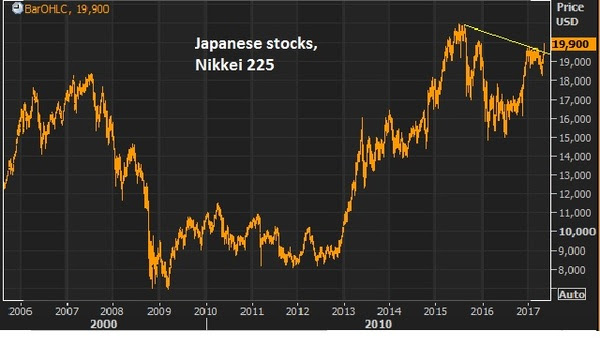|
May 8, 2017, 4:00pm EST Invest Alongside Billionaires For $297/Qtr
 For the skeptics on the bull market in stocks and the broader economy, the reasons to worry continue to get scratched off of the list.
For the skeptics on the bull market in stocks and the broader economy, the reasons to worry continue to get scratched off of the list.
Brexit. Russia. Trump’s protectionist threats. Trump’s inability to get policies legislated. The French election.
The bears, those looking for a recession around the corner and big slide in stocks, are losing ammunition for the story.
With the threat of instability from the French election now passed, these are two of the more intriguing catch-up trades.


Buffett essentially said at zero interest rates into perpetuity, the upside on the stock market (and any alternative asset class with return) is essentially infinite, as people are forced to find return by taking risk. Why you would buy a treasury bond that has no growth, and little-to-no yield and the same or worse balance sheet than high quality dividend stock.
This “forcing of the hand” (pushing investors into return producing assets) is an explicit objective by the interest rate policies of the Fed and the other major central banks of the world. They need us to buy stocks. They need us to spend money. They need economic growth.
If you have an brokerage account, and can read a weekly note from me, you can position yourself with the smartest investors in the world. Join us in The Billionaire’s Portfolio.
March 27, 2017, 4:00pm EST Invest Alongside Billionaires For $297/Qtr

This is the buy-the-rumor sell-the-fact phenomenon we’ve discussed. People bought on anticipation of a big policy shift. And now they’re taking profit (raising cash) waiting to see it all executed — the prove-it-to-me phase.
I think we’re beginning to see the same phenomenon unfold in the Brexit saga. Brexit came before Trump, but the cycle has been slower and longer. Much like the Trump trend, the Brexit news started with an initial “sell everything” on the fear of the unknown, but soon thereafter, the “buy on anticipation of something better” prevailed. But it’s looking very vulnerable now to a turn in the tide.
On Friday, we looked at this next chart. This trend higher in UK stocks looks much like the Trump trend in U.S. stocks – a nice 45 degree climb from June of last year.

But as we discussed on Friday, the “prove-it-to-me” phase looks set to arrive this week in the Brexit story. With that, here’s what the chart looks like today …

This nine-month trend line in UK stocks gave way today – in part because of the softening in expectations about Trump policies, but largely because the UK Prime Minister is expected to officially notify the European Union on Wednesday, of the UK’s exit from the EU. Again, this would start the clock on the two year wind-down of the UK constituency in the EU. And the official negotiations will begin, on what the UK/EU relationship will look like – namely, on trade.
Expect the negotiations to be ugly in the early stages. Why? Because there is a lot to lose if it looks too easy. The future of the European Union and the common currency (the euro) hang in the balance on these negotiations. The most important job of EU officials, at this stage, is keeping other EU members from hitting the eject button, following the lead of the UK. A domino effect of exits would kill the EU and it would be the end of the euro. And that would have huge, destabilizing global ramifications.
With all of this in mind, it’s very likely that after long period of ultra-low volatility in markets, things will be a little more dicey in the months ahead. That should keep pressure on yields and should keep the correction in U.S. stocks intact.
In our Billionaire’s Portfolio, we’re positioned in a portfolio of deep value stocks that all have the potential to do multiples of what broader stocks do — all stocks owned and influenced by the world’s smartest and most powerful billionaire investors. Join us today and we’ll send you our recently recorded portfolio review that steps through every stock in our portfolio, and the opportunities in each.

